Thanks, also noting that Doepfer modules probably don't have reverse polarity protection, so i've probably been lucky (nothing blown at this point)
Thanks, also noting that Doepfer modules probably don't have reverse polarity protection, so i've probably been lucky (nothing blown at this point)
Hi, I'm going to start building my first eurorack system and some advice is really appreciated to try to make the less mistakes possible. I'll be making hypnotic techno and the system is oriented to the performer side but also it will be used as studio case. Drum duties will be taken care of by Digitakt 2, as well as sampling and mangling stems from the modular. for the case, I've been considering the doepfer 9U 84hp or the intellijel 7U 104 hp. When designing both systems few compromises had to be done but my feeling is that the Intellijel case It's less dense, hence more playable and easier to patch but I might be wrong :) Please find below both of the systems. Thanks in advance for any comments.
Older thread discussing -12, 0 & 12V
“You must have chaos within you to give birth to a dancing star.”
― Friedrich Nietzsche
Man, I never feel that leftover module systems do much. I've had a few. They're left-over for a reason. I always find it better to stash them as long as I don't need the money.
In electrical circuits you always have a +Plus and a -Minus, think of it as turning on a light swtch to join the two and you get light.
Connecting your power cables the correct way around is important.
Enjoy your spare HP, don't rush to fill every last space, this is not like filling sticker books. Resist the urge to 'complete' your rack, its never complete so just relax.
Hi, yeah...i'm sure this question is super-ignorant, ultra-beginner level, and i'm showing my drastically limited understanding of electrical devices...but here goes
Why does my power supply module (which is the uZeuz power unit of the Tiptop Happy Ending 19" rack kit, but I presume this applies to many such units) have one supply for ribbon cable that is +12v and another for -minus 12v
I'm powering my modules off the + 12v, but can someone explain what the minus - 12 v is all about, and what that would be used for?
thanks T
It took me two playthroughs before I realized you're NOT somehow sampling sound from the record. :D
Very fun.
“You must have chaos within you to give birth to a dancing star.”
― Friedrich Nietzsche
With Marbles its sometimes a case of just slowing it down and extending the gate lengths, making sure to use nice long slow envelopes and plenty of reverb at the end.
Enjoy your spare HP, don't rush to fill every last space, this is not like filling sticker books. Resist the urge to 'complete' your rack, its never complete so just relax.
https://cdn.modulargrid.net/img/racks/modulargrid_2725653.jpg
As the title states, I am looking for some help with my latest addition to my rack, MI Marbles clone. I've had some success building patches with it, but I would love to get some insight from those of you with more experience than myself and particularly with the Marbles module or similar type modules. ideally I would like to create a slowly evolving ambient patch with Rings and/or Plaits. Patches I've previously made also included the Acronym Oscillator specifically for the sub oscillator harmonics it has. Additionally, Ive enjoyed patching different elements from each of the modules being used into my Erica Synths Joystick and modulating the different parameters I Choose with that module.
You'll find the link to my rack at the top of this post. I hope to get some helpful ideas from you all!
“You’ve got so many machines Richard!”
Hello mate, you have a nice setup for an ambient patch. I want to tell you that i have the same plants like you in my garden. By the end of the season they have been eaten by snails.
This is awesome! Super creative use of just a few modules. Gave me a few ideas I want to try out with my own setup.
Hello everybody,
Lately I´ve been working on a new project that I want to share with you.
Inspired by the quanta output of Rainbow Quantum 2.
I attached a minimal number of modules to an old vinyl record to create some sounds.
The LIQCS filter is set to self oscillation, highpass and lowpass output to the LPG, both outputs to a mixer.
Pamela is sequencing the LIQCS filter and the Zverb fills the gaps and adds some depth to the sound.
The kickdrum is generated with a envelop from Pamela´s output 6 to the filter, that was like magic.
And not to forget, the crackle from Rainbow Quantum 2 to the filter input 1.
Cheers.
Just ones planted outside :) Had a ton of fun working on this one, and even managed to catch a bunny and squirrel randomly interacting in the background! The best example of them starts at about 3:50 in the video.
Thank you so much ahead of time for those of you who give it a listen :)
Depending where you are you can try https://modulargrid.com or https://modulargrid.net
Beep, Bopp, Bleep: info@modulargrid.net
Please add Maffez
-- sibilant
done
Beep, Bopp, Bleep: info@modulargrid.net
It took a while but should be fixed. Thanks for reporting!
Beep, Bopp, Bleep: info@modulargrid.net
hi everyone ! i just bought the ml2m to sync up my eurorack with AUM on my ipad . but i cant seem to get AUM to find it at all ! can anyone help me with the setup please ? ive managed to get it on my home wifi network , and also run it as an access point but nothing seems to be working
Sorry folks didn't want to cause confusion here, this is just me toying around with thoughts around "The Analog Thing" (THAT) as a module. Wasn't aware that this might catch any attention, so I better set this back to hidden :)
It definitely got me for a second. I got excited that Doepfer decided to make something completely unorthodox, based on the success of the Analog Machine and the Collide4.
Not totally sure what's going on here but it's an interesting concept! Thought it was a real upcoming Doepfer module for a moment. The layout could probably be 4hp smaller if you reduce the horizontal gaps between the functional blocks.
This is the latest version of my session case. At its core there is the sythesis West Coast philosphy, and it is heavily designed to follow improvisation flow
This current synth is an improvisation machine. It receives input from external instruments and influences randomly generated sequences.
Zero compromise. Massive knobs, giant switches, I'm in love.
Bravo, Big Up!!! Fantastic project.... Really hope develloppers will be interest by this and feed it.... I 'll keep an eye on it to see the demos and....why not to buy it , ...if it's really a swiss knife : big oscilloscope with min. 4 voices(+2 expanders) + poly synth + audio interface +video synthesis + whatever??
How many colors for the video?
Best
Combine a modular synth with a wind gauge and you get what we might call an electro-aerophone: an electronic instrument that can transform the wind into music … and, in the process, reconnect us to our environment.
After patching a wind chime in the last video, here I simulate an Aeolian harp with the help of an eight-band resonating filter bank, a comparator, and an addressable sequential switch.
A new video on my channel!
Samples, loops, fuzzy pads and synthesized vocals. More info under the video on YT!
Have a nice listen! Hope you will like it. 🌿
Hi everyone,
I'm a newbie here and am looking for some insight. I have a Doepfer P9 case and it only supports up to 12v/2000 mA, which my system will most definitely exceed. I recently discovered power modules like the "Tiptop Audio uZeus" or the "After Later Audio Warp Drvie". I wanted to ask if adding one of these modules and tape the flying bus board inside the case would be a possible solution to extend my ampere. If so any concern like ground noise, inteference or safety issues that I should pay attention to?
Thank you very much,
Jeff.
Just got a reply from Plankton Electronics:
”this is a DIY unit.
There is no serial number (look at the white box it is blank, we write there the S/N manually).
Some soldering paths are not professional, we don't offer that quality.
One of the headers is melted. We will never sell that.
The red strip box is painted bad (we always cover it all)
Guillermo Cantalapiedra was one of the bakers of the Kickstarter campaign on 2019. He pledged for the 3 modules DIY kit.
I'm sorry if he sold you something that is not what he claims it is.”
Adding more photos for reference.
The seller calls himself "gcanta" on Modular Grid.
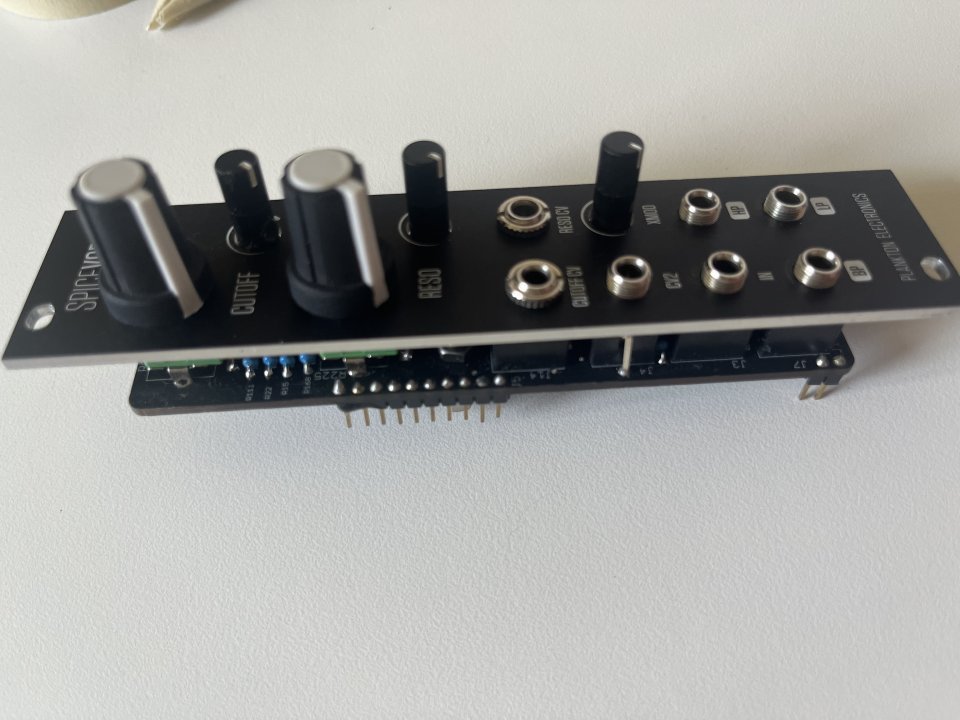
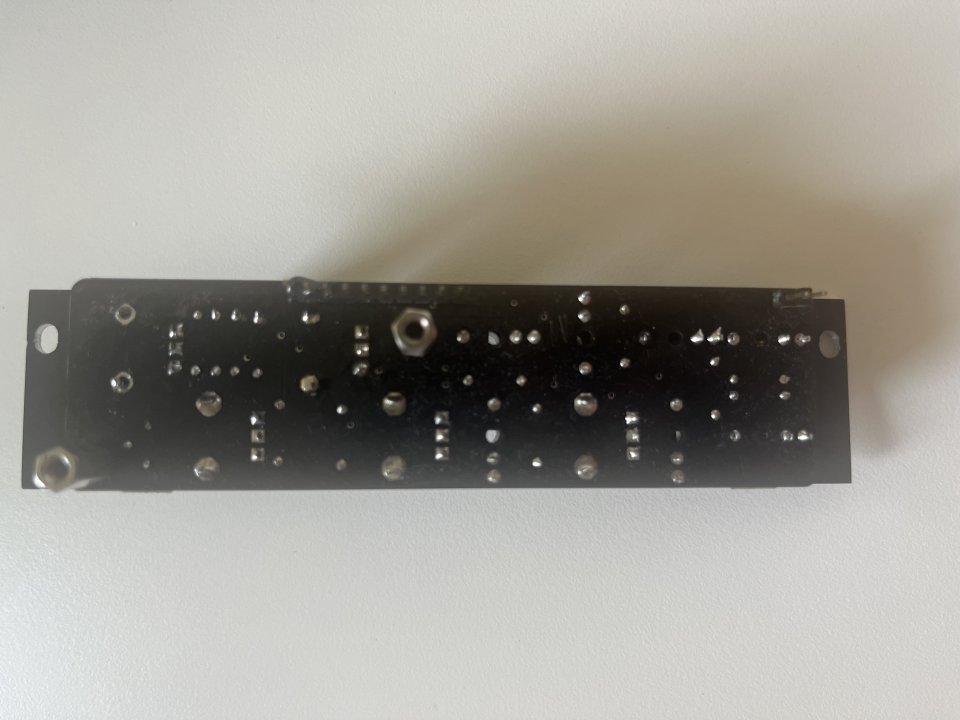
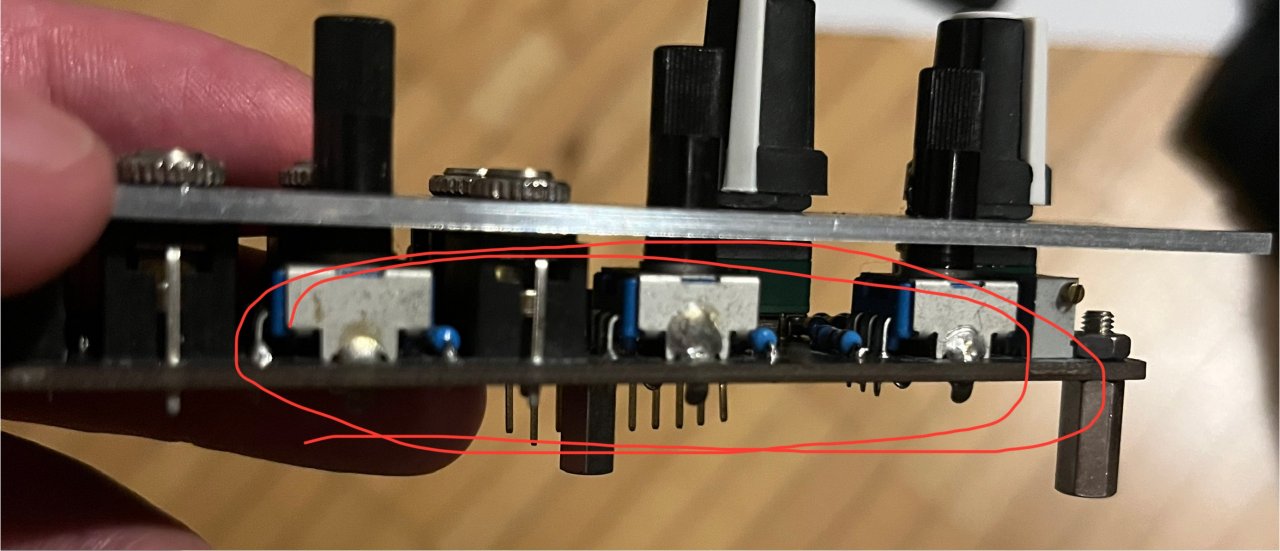

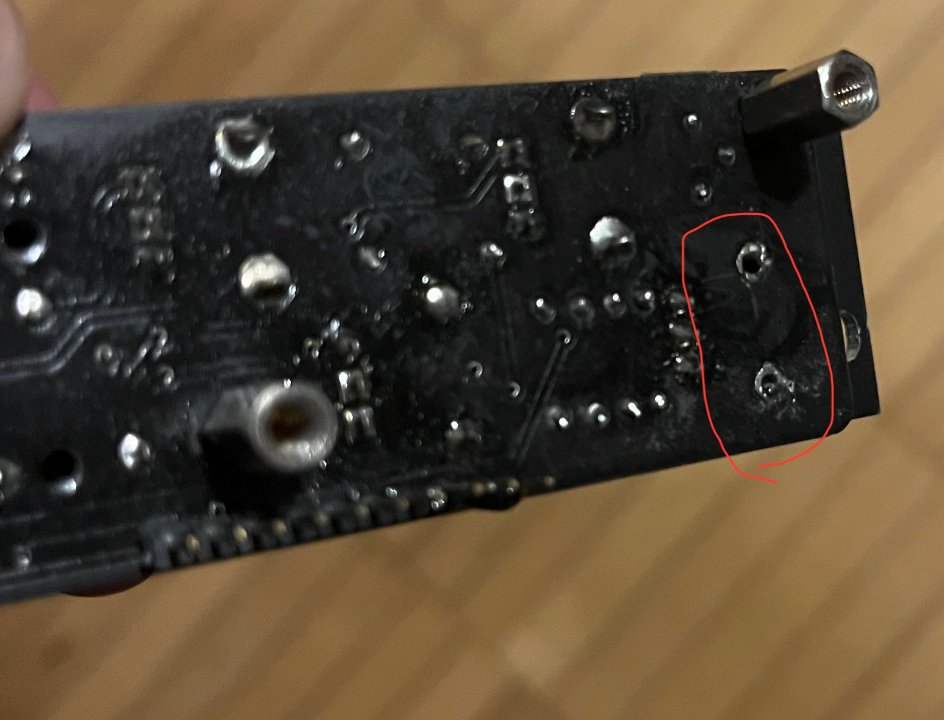 I bough a Plankton Electronics Spice VCF from a guy in Spain called Guillermo Cantalapiedra. I was told the module worked as expected and no info of any faults or that it was a DIY. When I got the package I quickly installed the module and tried it out. Almost immediately I noticed that something was wrong because the resonance knob didn’t work. I tried a couple of different sound sources, waveforms and pitches, but still no change in sound when turning the knob from max to min. I then shut everything off and pulled out the module. Upon inspection I could see this was a DIY, and a really bad one. Probably one of the worst I’ve seen. Obviously that is why the module is not working properly. I reached out and the seller told me ”I’m using it wrong” and that the resonance has to be CV controlled. He also denied that the module is a DIY. The case has been escalated at PayPal but I’m not sure it will be solved amicably since the seller first refused to take the module back and then wants me to send it without paying me back first.
I bough a Plankton Electronics Spice VCF from a guy in Spain called Guillermo Cantalapiedra. I was told the module worked as expected and no info of any faults or that it was a DIY. When I got the package I quickly installed the module and tried it out. Almost immediately I noticed that something was wrong because the resonance knob didn’t work. I tried a couple of different sound sources, waveforms and pitches, but still no change in sound when turning the knob from max to min. I then shut everything off and pulled out the module. Upon inspection I could see this was a DIY, and a really bad one. Probably one of the worst I’ve seen. Obviously that is why the module is not working properly. I reached out and the seller told me ”I’m using it wrong” and that the resonance has to be CV controlled. He also denied that the module is a DIY. The case has been escalated at PayPal but I’m not sure it will be solved amicably since the seller first refused to take the module back and then wants me to send it without paying me back first.
Thanks, that's an idea, I'm reluctant on selling but having them in a box waiting for use is a bit dis-spiriting-although I have other priorities right now.
I only have this ragbag left overs coz my original case wasn't powerul enough to run my system with added (and essential) Tiptop ONEs without intermittent pitch dropping issues. Performability led me down a tortuous path to smaller performable case.
People are goofy. I do not think it maters one little bit what you put in your rack or how you use it.
Also, haveing a plan is all well and good, but from my experience, it took me a while to figure out what I wanted.
I have a euroburrow, but do not really use it. Do you have any videos of hwo you use it?
The semi modulars usually have some sort of side panels which are detachable. For the Neutron I timbered some fitting panels out of beech wood and screwed it on top of my rack. Saves precious rackspace and you can still patch it as if it were in the rack.
-- CoogLFish
That looks really nice. I was at a show recently when an artist was using the Neutron. It sounded incredible outof the PA.
Honestly this is a pretty well balanced and capable rack, particularly alongside the other gear you mentioned! This is a matter of taste, but I reworked the layout of it to provide a more intuitive workflow: 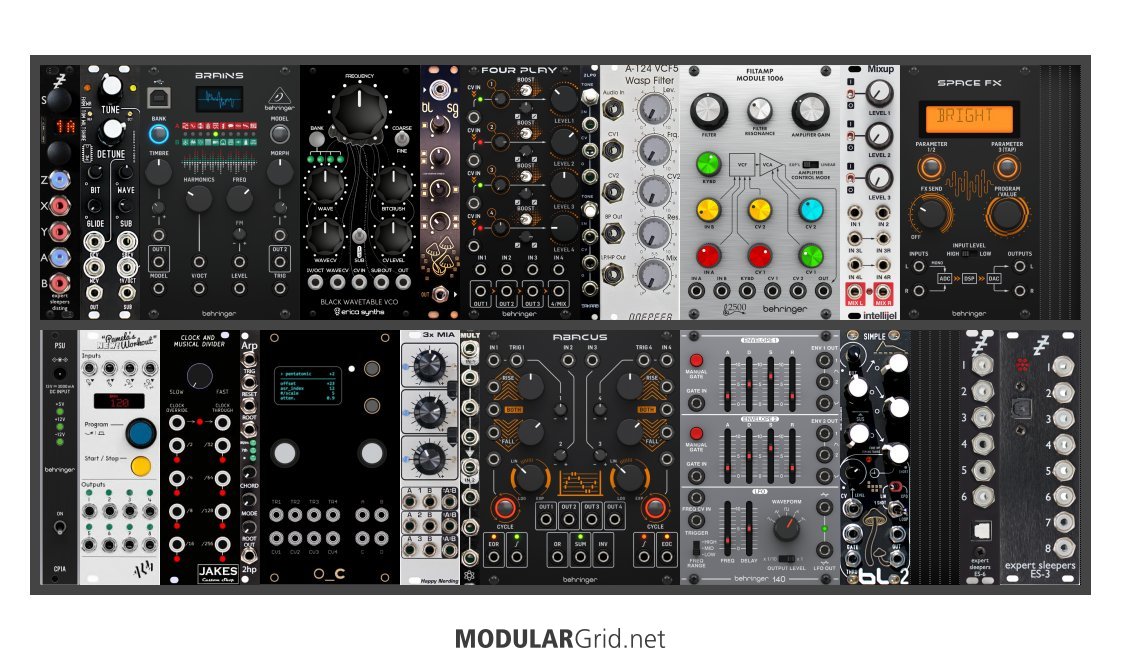
Do with that what you will! This is roughly the ARP 2600 philosophy, sound sources together flowing into filters/vcas then flowing to effects, with clocks, pitch cv, modulation cv and mixers grouped together as well. I find it makes patching a little quicker and easier when you keep a consistent layout along these lines.
My advice for what you should add next: I'm a big fan of using Disting, O&C, and Pams, keeping track of what you're using the most consistently and considering if you want to get a standalone module for doing that thing. For example, I use the Hemispheres firmware on my O&C, and found that I was using it as a min/max and comparator quite a bit, so I got modules suited to those specific uses and can explore the other uses of the O&C again. Happy patching friend!
I have a Mavis in my modular setup because of its utility.
For $299 you get:
- A Moog oscialltor with PWM (!)
- A Moog LPF (!)
- An LFO
- An ADSR
- A lil' mult
- An attenuator
- A lil' mixer
- A (very basic) keyboard controller
What other $299 semi-modular or module gives you that much stuff?
Seriously! I'm curious.
what modules am i missing?
(dangerous question for me!)
just getting into eurorack - using these as an extension of my Model 15 also using Korg Sq-1, EDGE, and Crave, and Drumbrute Impact, Keystep Pro.
This semi-generative piece uses an Eventide Misha to step through chord triads. The pitches are sent to 4MS Spherical Wavetable Navigator (SWN) and Xaoc Devices Odessa as the main voices in this patch. 2hp Pluck (wavefolded by an output from Odessa) and Plaits (through Aurora) provide the intermittent percussive elements. I'm using 4MS Quad Clock Distributor to feed multiples of the clock to various modules and alter the clock in 4MS Dual Looping Delay (DLD) which adds the glitchy repeats to SWN.
The main "human intervention" in the patch is adjusting the Xaoc Zagrzeb filter that SWN goes through, changing the rate of Erica Pico Rand (which triggers chord changes in Misha), and adjusting the spectral content Odessa is producing.
kalimba → Boredbrain UniFX → Instruo Lubadh (looping with loop start position being modulated) → Xaoc Timiszoara (for shimmer)
4MS Rotating Clock Divider → toggle the 4MS DLD reverse/hold switches
2x Instruo 0chd's → modulate all the things
4MS SWN LFOs → modulate more things
The M2CV stuff is supposed to go in a powered skiff box and be used for more than just the Proton with the stochastic module in it. Everything is seperately powered. Not just rack if I build it.
This looks interesting. What was your application for this? Specifically, why so many M2CV modules?
This looks interesting. What was your application for this? Specifically, why so many M2CV modules?
New video:
I recently returned from a journey to Japan. It was a deeply inspiring trip. I brought my recorder everywhere. I captured sounds in Tokyo and Kyoto…from shrines, streets, and quiet corners. I recorded crows near Meiji Shrine. I found bell tones echoing through old temples. In the Japanese Alps, I followed forest paths. I recorded bear bells on the Nakasendo trail.
And soft footsteps on ancient monastery floors. At Eiheiji, an 800-year-old Zen temple, I captured resonating bowls
and birds singing in the early morning
I loaded all the samples into Multigrain.
These textures are the foundation for a new EP.
But I couldn’t resist experimenting early.
This piece grew out of a soundscape.
Bear bells, water drips, floor creaks…
Clicking sounds from inside a wooden ryokan.
From these, a slow melody emerged.
It builds gently, almost like mist rising.
I hope you enjoy this piece!
Raaf
Select Seed in Cross Op and select another PPW output for Seed Src. set the selected output to pulse when you want a new seed. ALM did vids on this here is the first one
Hi all, made a song this week that I wanted to share ^_^
I've been enjoying experimenting with the Chromaplane, the latest addition to my home studio. After coming across a very nice arpeggio on the Solar 42f, I wanted to pair it up with some longer, more noisy sounds from the Chromaplane. This became the result of it, with some added pads and bass as well ^_^
For those interested in the modules: an important module in this song was the Acabus (a Maths clone), which I used a couple of LFOs to generate some envelopes that modulated the filter and the delay of the Chromaplane. The audio output of the Chromaplane was then routed through Lyra-8 for some extra weird delays and gritty drive, and then through cDVCA for filtering and even more gritty drive.
I've been thinking about expanding my home studio with some preamp- and EQ-modules, and thought I would share my thinking here, in case I've forgotten something obvious, or should consider other alternatives.
To give a bit of context: My home studio consists of various Eurorack modules, synthesizers and a laptop running Ableton Live. All go into patchbay where I duplicate the audio signals into A and B; A goes into a 10-track mixer with 12 channels (two of the tracks are stereo), and B goes into ES-9 (except the audio from the laptop - I don't need to record this separately). The sum of the mixer is then recorded using Focusrite 2i2 3rd gen.
This means I end up recording 2 channels of wet stereo from the mixer (as the mixer have an Aux channel that sends to a reverb pedal), and up 10 dry channels (in the sense that they haven't been mixed with the reverb pedal), resulting from the 9 remaining tracks after removing the track for the laptop.
A problem with the current setup is that the ES-9 is designed for audio from Eurorack modules, so instruments that send Line signals will be low. This hasn't been a to big of a problem for me, as I've limited myself to only use these single tracks to "back up" certain parts of the mix (to enhance certain parts, etc). But it's been an annoyance, and I've decided that I want to try to find a solution.
Another part of the context is the form factor that I want to use for this: I used to have a DFAM that I sadly lost because of a drunken mistake during a jam (sidenote: you should always label your power cords), but I still use its case to house various modules. It fits very neatly next to the mixer, it houses the ES-9 currently, and I would like to continue using it as rack for this solution. So that means one row of 60hp.
After some iterations I've ended up with the following:
With this setup I can boost and adjust EQ for 12 channels. The limitation is that only 4 channels can be individually adjusted, so the remaining 8 are probably best used for stereo, which is ok for me. The idea is to have all tracks (except the stereo channel used by the laptop) be routed through the various preamps and EQs (the laptop will go "directly" to the mixer via the main outputs of the ES-9) to the patchbay, where the signals are duplicated, one going back to the ES-9 and the other into the mixer (which also returns a stereo channel to the ES-9).
Granted, signals coming from Eurorack modules directly won't have much need for the gain modules, so I could drop some there, but I'm ok with having some redundant modules from time to time if that means that the final design is simpler to comprehend.
I also think I need to boost the signal coming from the mixer (something the 2i2 handles for me today), so the left-most BaxandallEQ is designated the sum-signal from the mixer. Alternatively I could still use the 2i2 for this, but I would like to free up this for other purposes.
An alternative to this is to go with something much simpler, like the Focusrite 18i20. The drawback of this is that if I want to have 12 channels (to match the mixer) I would have to buy an extension. (That said, it would probably still be cheaper than the solution above.) But I would not get the EQ-functionality, and in the solution above all channels have their own gain knob, which I appreciate.
Again, I appreciate any feedback. I recognize my setup can be somewhat confusing, but I hope I was able to convey how it works, and how I would like it to work ^_^
Edit 1: Added some context regard the size of the rack.
Hello fellow GAS guys,
I've been searching the manual, on Google and asking AI, but I don't seem to find a clear answer. You guys will know, I'm sure. I'm sorry if it's an obvious thing I happen to have looked past. I'm fairly new to this thing (my GAS turned 1 year old a few days ago) ;-)
The question:
When I have an output of the PPW configured to send out random voltages looped on 16 steps for instance. How do I tell it to generate a new seed for the loop without stopping playback? Is it done by reducing the looping steps to 0 and back up to 16 to reseed the loop, or is there another way? Some button combo that can be used? Can I trigger it via CV somehow?
I see it can easily be done by using another module for the random loop, a turing machine or mimetis for instance, but I don't have those (yet) and I would like to know if PPW can do that too somehow.
Thanks in advance for your experience and insights!